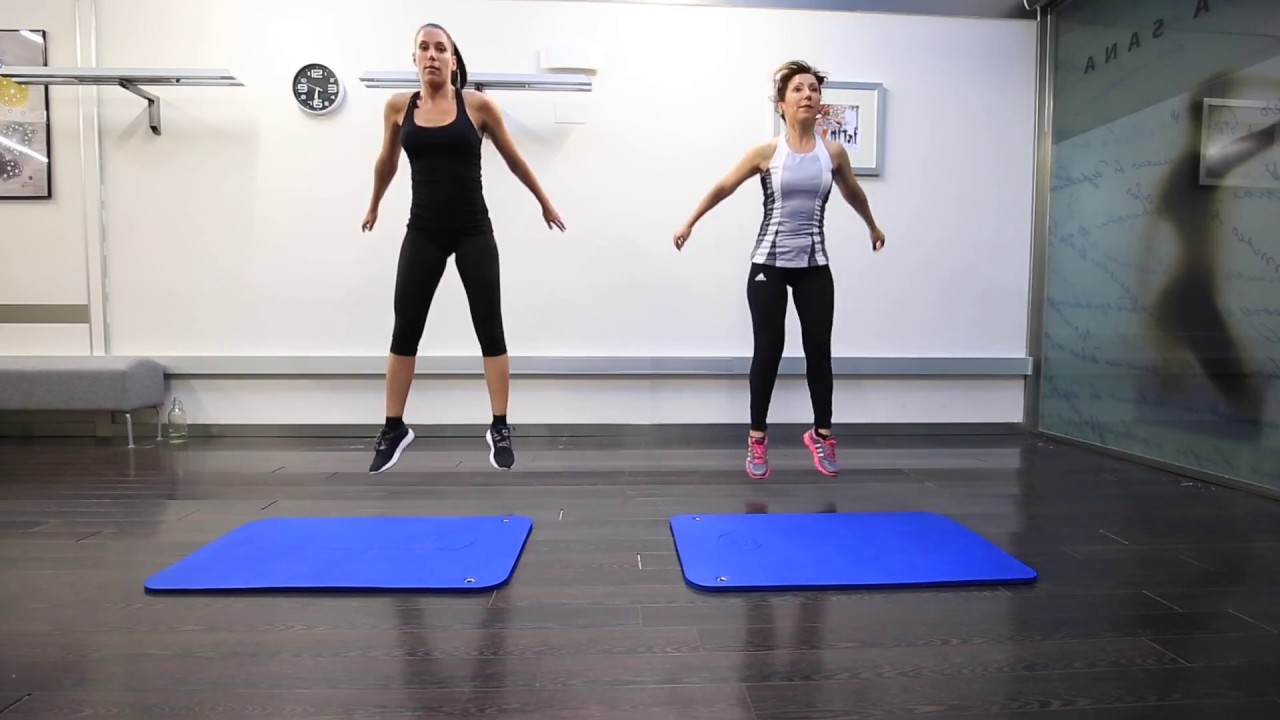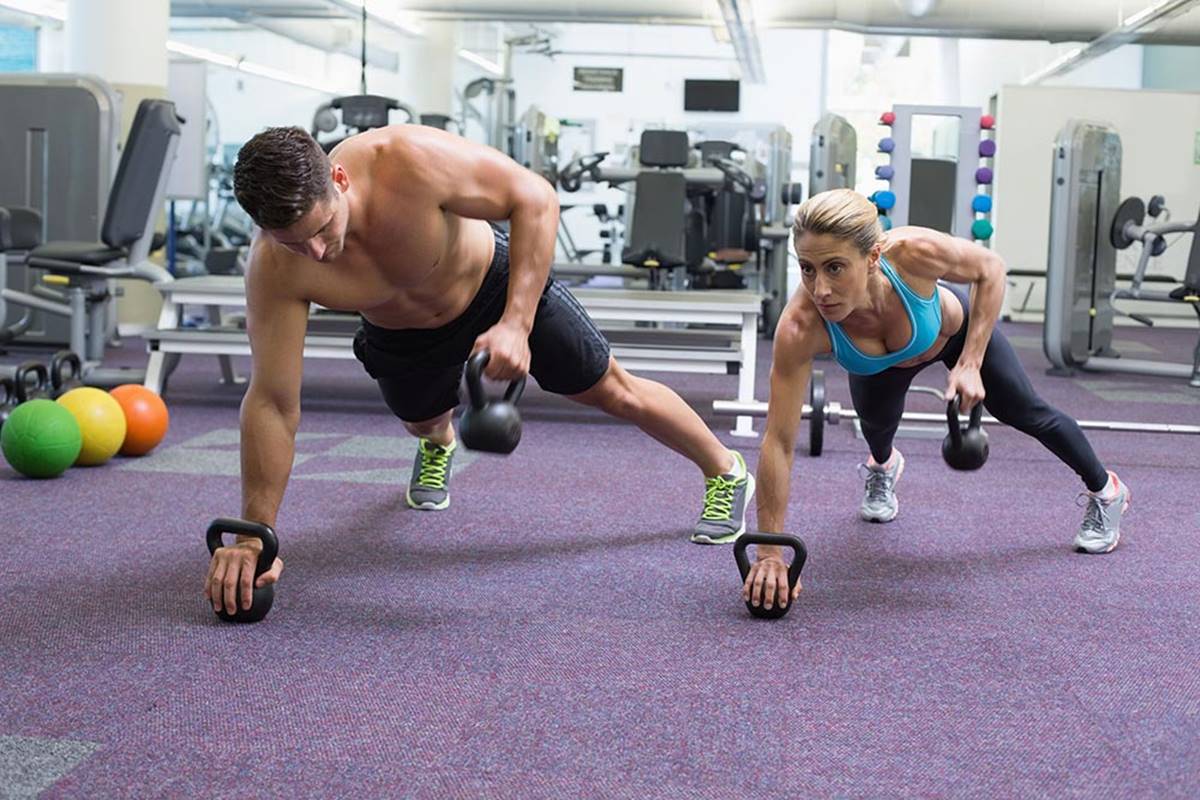

Featured
What Is A HIIT Workout
Modified: August 21, 2023
Discover the benefits of a HIIT workout with our featured article. Learn how this high-intensity training can help you achieve your fitness goals efficiently and effectively.
Introduction
Have you ever wondered how to get the most out of your workouts in less time? Look no further than High-Intensity Interval Training (HIIT). In recent years, HIIT workouts have gained immense popularity for their ability to burn calories, improve cardiovascular fitness, and build strength in a short amount of time.
HIIT workouts are characterized by short bursts of intense exercise followed by brief periods of rest or low-intensity activity. This style of training not only challenges your body but also keeps your workouts exciting and dynamic.
In this article, we will explore what exactly a HIIT workout is, the benefits of incorporating it into your fitness routine, how it works, and provide you with a sample HIIT workout routine to get you started on your fitness journey.
Whether you are a beginner looking to kickstart your fitness journey or an avid fitness enthusiast striving to take your workouts to the next level, HIIT workouts have something to offer for everyone. So, let’s dive in and discover the power of HIIT training!
Definition of HIIT Workout
High-Intensity Interval Training (HIIT) is a form of exercise that involves short bursts of intense activity followed by periods of rest or lower intensity exercise. The intervals can vary in duration, typically ranging from 20 seconds to several minutes, depending on the fitness level and goals of the individual. These intense intervals are repeated in a circuit-like fashion, creating a highly efficient and time-saving workout.
What sets HIIT workouts apart from traditional steady-state exercises, such as jogging or cycling, is the intensity at which the exercises are performed. During the high-intensity intervals, individuals push themselves to near maximum effort, reaching their anaerobic threshold. This level of intensity challenges the cardiovascular system and activates fast-twitch muscle fibers, leading to increased calorie burn and improved cardiovascular fitness.
While HIIT workouts are often associated with cardiovascular exercises like running or cycling, the beauty of HIIT lies in its versatility. It can be implemented with various exercises, including bodyweight movements, resistance training, plyometrics, and even cardio equipment like rowing machines or ellipticals. This flexibility allows individuals to tailor their workouts to their specific preferences and goals.
Typically, a HIIT workout follows a structured pattern, alternating between high-intensity exercises and brief recovery periods. The number of intervals and duration of each interval can be varied based on the individual’s fitness level and desired intensity. The overall goal is to maximize effort during the high-intensity intervals and allow adequate rest or active recovery during the rest periods.
Overall, a HIIT workout is an efficient way to boost cardiovascular fitness, burn calories, and improve muscular endurance. By incorporating short bursts of intense exercise followed by brief recovery periods, HIIT workouts offer a time-saving alternative to traditional steady-state training and provide numerous health benefits.
Benefits of HIIT Workouts
High-Intensity Interval Training (HIIT) workouts have gained popularity due to their numerous benefits for both physical fitness and overall health. Here are some of the key advantages of incorporating HIIT into your fitness routine:
1. Efficient Calorie Burn: HIIT workouts are known for their ability to burn a high number of calories in a short amount of time. The intense intervals push your body to work at its maximum capacity, leading to an increased metabolic rate and calorie burn even after the workout is over.
2. Improved Cardiovascular Fitness: HIIT training challenges your cardiovascular system by pushing it to its limits during the high-intensity intervals. This helps to improve cardiovascular endurance, increase the efficiency of your heart and lungs, and boost overall cardiovascular health.
3. Muscle Gain and Strength Development: HIIT workouts incorporate various types of exercises, including bodyweight and resistance training. This combination helps to build lean muscle mass and improve overall muscle strength and tone. The explosive movements and heavy resistance used in HIIT workouts stimulate muscle growth and enhance overall athletic performance.
4. Time-Saving: One of the major advantages of HIIT workouts is their efficiency. With shorter periods of intense exercise and brief rest intervals, you can achieve the same or even better results than traditional steady-state workouts in a fraction of the time. This makes HIIT ideal for individuals with busy schedules who struggle to find long periods for exercise.
5. Increased Metabolic Rate: HIIT workouts have been shown to boost your metabolic rate, both during and after the workout. This means that your body continues to burn calories and fat at an increased rate even after you’ve finished exercising, leading to potential weight loss and improved body composition.
6. Enhanced Endurance and Stamina: HIIT workouts are designed to push your limits and improve your endurance levels. By regularly challenging yourself with intense intervals, your body adapts and becomes more efficient at delivering oxygen to your muscles. This leads to increased stamina and improved performance in other activities or sports.
7. Flexible and Varied: HIIT workouts can be customized to suit individual preferences and fitness levels. You can choose from a wide range of exercises and tailor the duration and intensity of each interval to meet your specific goals. This versatility also helps to keep workouts interesting, preventing boredom and maintaining long-term adherence to a fitness routine.
Incorporating regular HIIT workouts into your fitness routine can provide a multitude of benefits, from improved cardiovascular fitness and increased calorie burn to enhanced muscle tone and strength. So, why not give HIIT a try and experience the transformative power of these high-intensity workouts?
How Does HIIT Work?
High-Intensity Interval Training (HIIT) works by challenging your body to perform at a high level of intensity for short bursts of time, interspersed with periods of rest or lower intensity exercise. This novel approach to training triggers physiological responses in the body that lead to various fitness benefits. Here’s a breakdown of how HIIT works:
1. Cardiovascular Conditioning: During the high-intensity intervals of HIIT, your heart rate rapidly increases, pushing your cardiovascular system to work harder. This elevated heart rate improves the efficiency of your heart and lungs, leading to better oxygen delivery to your muscles and improved cardiovascular fitness.
2. Calorie Burn and Fat Loss: HIIT workouts promote calorie burn and fat loss through the concept of excess post-exercise oxygen consumption (EPOC), also known as the “afterburn effect.” The intense effort during the intervals creates an oxygen debt, which your body repays during the recovery periods. This process requires energy, resulting in continued calorie burn even after the workout is over.
3. Muscle Building: By incorporating resistance exercises or explosive movements during the high-intensity intervals, HIIT workouts stimulate the recruitment of fast-twitch muscle fibers. These fibers have a higher potential for growth and strength development, leading to improved muscle tone and increased muscle mass over time.
4. Metabolic Boost: The high-intensity intervals of HIIT raise your metabolic rate significantly during the workout and keep it elevated for hours afterward. This metabolic boost not only promotes calorie burn but also helps regulate insulin sensitivity, potentially aiding in weight management and improving overall metabolic health.
5. Hormonal Response: HIIT workouts trigger the release of various hormones in the body, including adrenaline and human growth hormone (HGH). These hormones play a key role in mobilizing stored fat for energy, promoting muscle growth, and enhancing overall athletic performance.
6. Time Efficiency: The structured format of HIIT allows you to achieve maximum results in a short amount of time. With shorter workouts that combine periods of intense effort and recovery, you can fit an effective workout into your busy schedule without sacrificing efficiency.
It’s important to note that HIIT workouts should be tailored to your fitness level and capabilities. Gradually increase the intensity and duration of your intervals as you become more comfortable and fitter.
Incorporating HIIT into your fitness routine can provide a wide range of benefits, including improved cardiovascular fitness, increased calorie burn, enhanced muscle tone, and a metabolic boost. By pushing yourself to your limits during intense intervals and allowing for adequate rest, you can unlock the full potential of HIIT and take your fitness to new heights.
Sample HIIT Workout Routine
Now that you understand the concept and benefits of High-Intensity Interval Training (HIIT), let’s take a look at a sample HIIT workout routine to get you started on your fitness journey. Remember to warm up properly before starting the workout and modify the exercises and intensity level to suit your fitness level and capabilities.
1. Jump Rope Intervals:
- Perform 30 seconds of intense jump rope skipping.
- Followed by a 15-second rest or slow-paced jump rope skipping.
- Repeat this cycle for 10 sets.
2. Bodyweight Squat Jumps:
- Perform 20 seconds of explosive squat jumps.
- Followed by a 10-second rest.
- Repeat this cycle for 8 sets.
3. Mountain Climbers:
- Perform 30 seconds of mountain climbers.
- Followed by a 15-second rest in a plank position.
- Repeat this cycle for 10 sets.
4. Burpees:
- Perform 20 seconds of burpees.
- Followed by a 10-second rest.
- Repeat this cycle for 8 sets.
5. Sprints:
- Find an open space or use a treadmill.
- Perform a 30-second all-out sprint.
- Followed by a 30-second recovery walk or jog.
- Repeat this cycle for 10 sets.
6. Plank Variations:
- Perform a 30-second forearm plank.
- Followed by a 15-second rest.
- Repeat this cycle for 8 sets.
This sample HIIT workout routine incorporates a mix of cardiovascular exercises, plyometrics, and strength-focused movements. It targets different muscle groups and keeps your heart rate elevated throughout the workout.
Remember to listen to your body and adjust the intensity or modify the exercises as needed. It’s always a good idea to consult with a fitness professional before starting any new exercise program, especially if you have any underlying health concerns.
Be consistent with your HIIT workouts, aiming for 2-3 sessions per week, to experience the full benefits. As you progress, you can gradually increase the duration of the intervals or add more challenging exercises to keep pushing yourself.
Enjoy the intensity and variety of HIIT training as you strive towards your fitness goals!
Precautions and Safety Tips for HIIT Workouts
While High-Intensity Interval Training (HIIT) can be an effective and stimulating workout method, it is important to approach it with caution and prioritize safety. Here are some precautions and safety tips to keep in mind when incorporating HIIT into your fitness routine:
1. Warm Up Properly: Before starting a HIIT workout, always warm up your muscles and joints to prepare them for the intense activity. This can include dynamic stretches, light cardio exercises, and mobility drills to increase blood flow and flexibility.
2. Start Slowly: If you are new to HIIT or have any underlying health conditions, it’s crucial to start slowly and gradually increase the intensity and duration of your intervals. Listen to your body and allow yourself time to adapt and build endurance.
3. Proper Form and Technique: Pay close attention to your form and technique during each exercise to minimize the risk of injury. Perform the movements with control and engage the correct muscles to ensure proper alignment and stability.
4. Rest and Recovery: Allow yourself enough rest and recovery between workouts to avoid overtraining and decrease the risk of injury. HIIT workouts can be demanding on the body, so scheduling rest days and incorporating active recovery activities like stretching and foam rolling is essential.
5. Stay Hydrated: HIIT workouts can make you sweat profusely, so it’s important to stay hydrated throughout your workout. Drink water before, during, and after your session to replace fluids lost through sweat.
6. Listen to Your Body: Pay attention to any warning signs or discomfort during your HIIT workouts. If you experience excessive pain, dizziness, or shortness of breath, it’s crucial to stop exercising and seek medical attention if needed.
7. Progress Gradually: As you become fitter and more comfortable with HIIT workouts, you can gradually increase the intensity, duration, or complexity of your intervals. However, avoid progressing too quickly, as this can lead to overexertion and potential injuries.
8. Modify Exercises: If you have any pre-existing injuries or physical limitations, it may be necessary to modify certain exercises to accommodate your needs. Consult with a fitness professional to find suitable alternatives that won’t exacerbate your condition.
9. Use Proper Equipment: When performing HIIT workouts, ensure that you have proper footwear, supportive clothing, and any necessary equipment. This can help prevent injuries and provide stability during high-impact exercises.
10. Listen to Professional Guidance: If you are new to HIIT or unsure about proper technique and programming, consider working with a qualified fitness professional who can guide you through the process and ensure your workouts are safe and effective.
By following these precautions and safety tips, you can minimize the risk of injury and make the most of your HIIT workouts. Remember, your health and well-being should always be the top priority. Stay safe, have fun, and enjoy the benefits of this challenging and rewarding training method!
Conclusion
High-Intensity Interval Training (HIIT) has revolutionized the fitness world by providing a time-efficient and effective way to boost overall fitness levels. With its intense bursts of exercise followed by short recovery periods, HIIT offers numerous benefits, including improved cardiovascular fitness, increased calorie burn, muscle building, and metabolic boosting.
By incorporating HIIT into your fitness routine, you can achieve remarkable results in a shorter amount of time compared to traditional steady-state exercises. Whether you are a beginner or an experienced fitness enthusiast, HIIT can be tailored to your fitness level and goals, allowing you to progress at your own pace.
However, it is crucial to approach HIIT workouts with caution and prioritize safety. Pay attention to proper form and technique, warm up adequately, and listen to your body’s signals. Gradually increase the intensity and duration of your intervals, and make sure to include rest and recovery days to prevent overtraining and reduce the risk of injury.
Remember, HIIT is just one tool in your fitness arsenal. It can be combined with other forms of exercise, such as strength training and flexibility exercises, to create a well-rounded fitness routine. Additionally, consult with a fitness professional if you have any underlying health conditions or are new to HIIT to ensure that you are following a safe and suitable program.
Overall, incorporating HIIT into your fitness routine can provide a challenging and exciting way to achieve your fitness goals. Stay motivated, stay consistent, and enjoy the incredible benefits that HIIT workouts have to offer. So, lace up your sneakers, get ready to sweat, and embrace the power of HIIT to transform your fitness journey.









